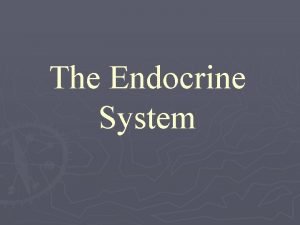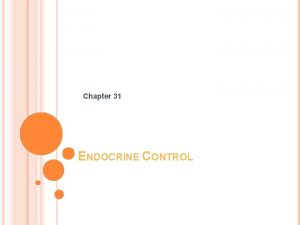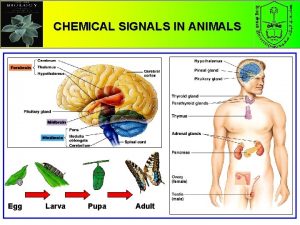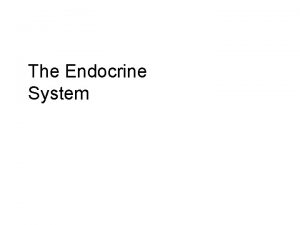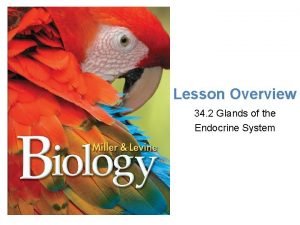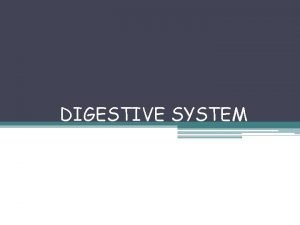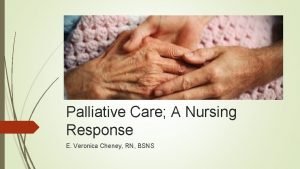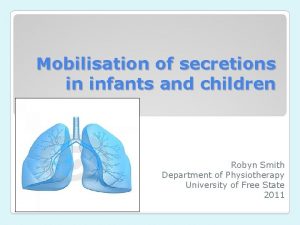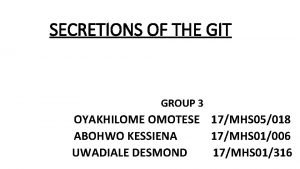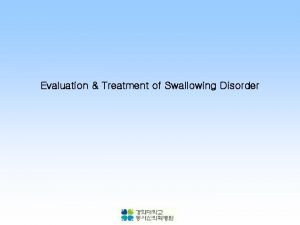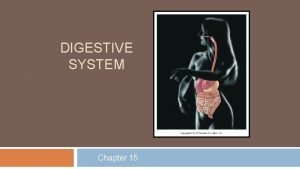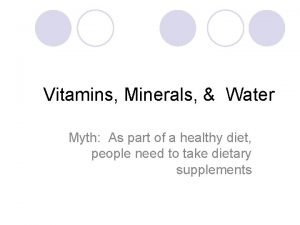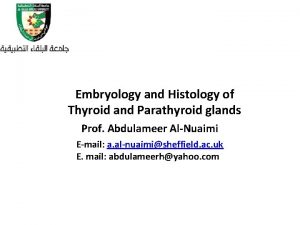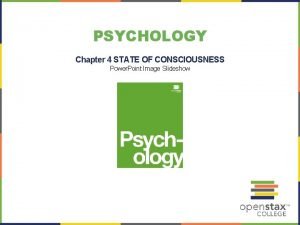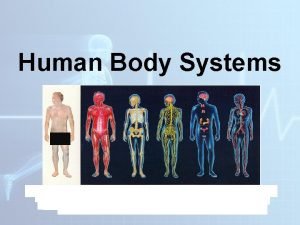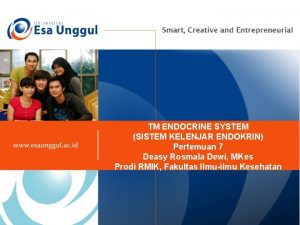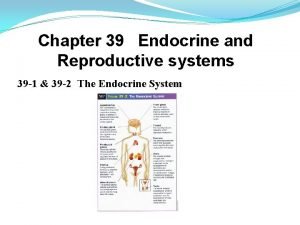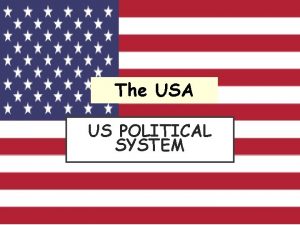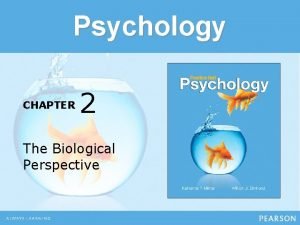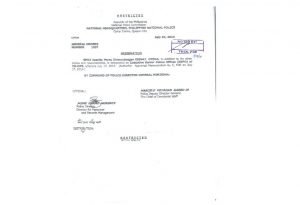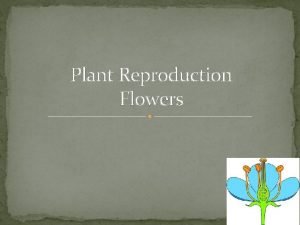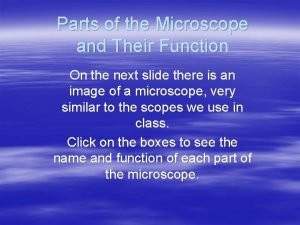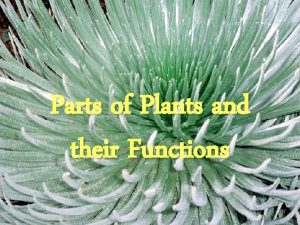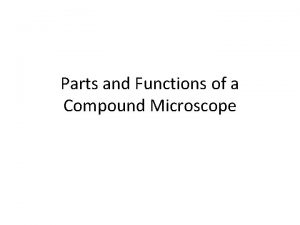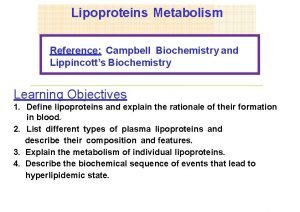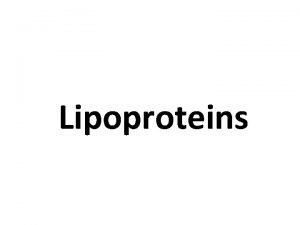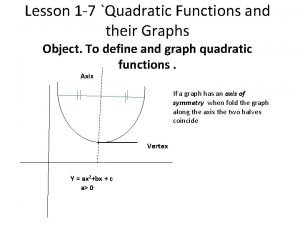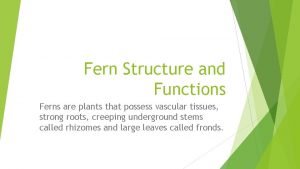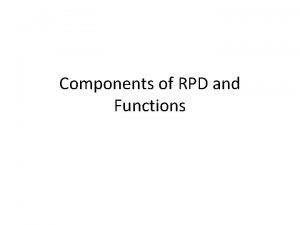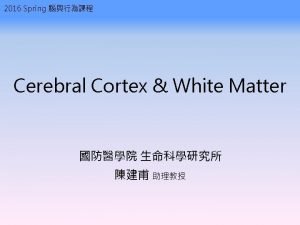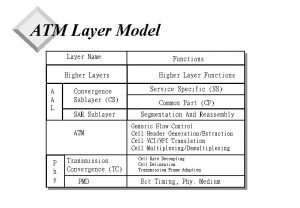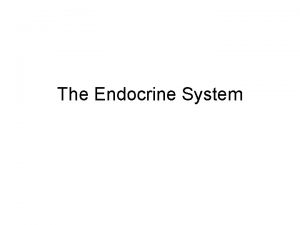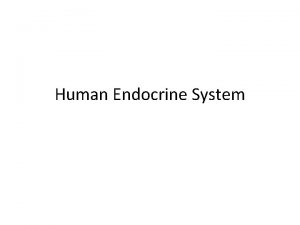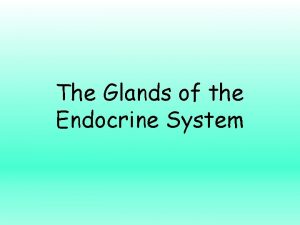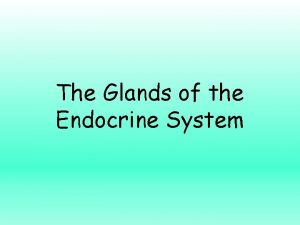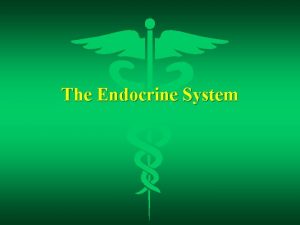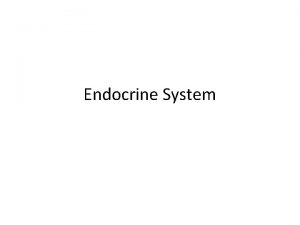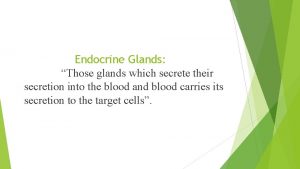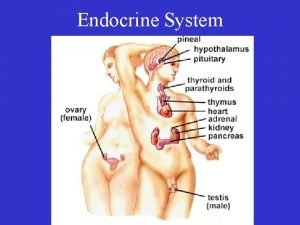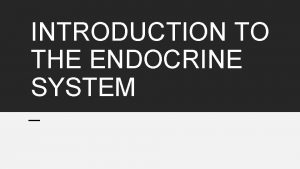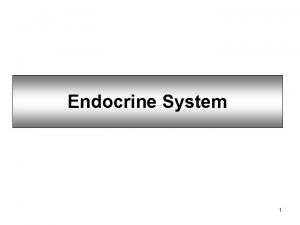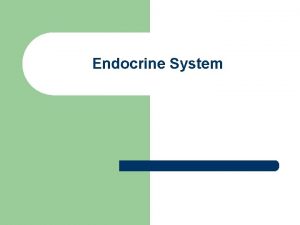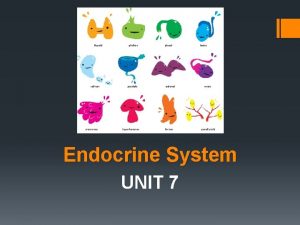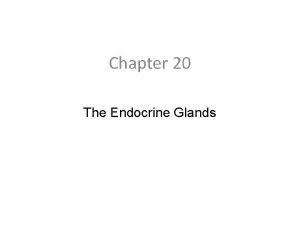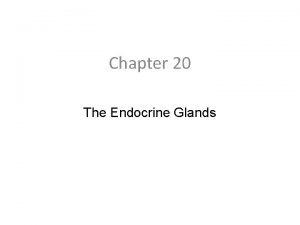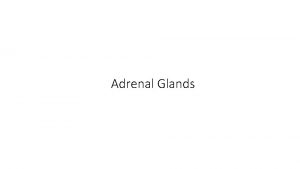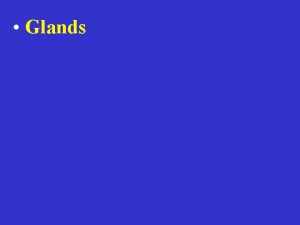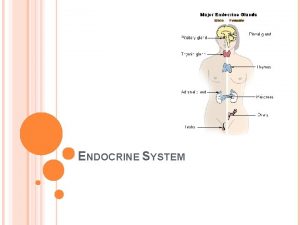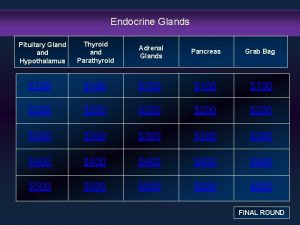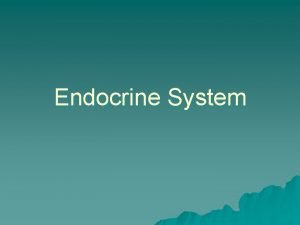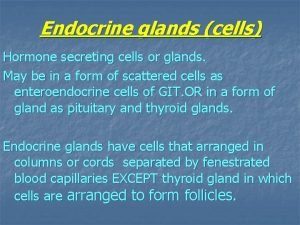HUMAN ENDOCRINE GLANDS AND THEIR SECRETIONS n FUNCTIONS
























































- Slides: 56

HUMAN ENDOCRINE GLANDS AND THEIR SECRETIONS

n FUNCTIONS OF ENDOCRINE SYSTEM n Coordination of different parts n Passage of information through chemicals n Compratively slower n Not connected to target sites directly n Controls Growth and Development n Chemical message lasts for longer period

GLAND A cell, tissue or organ that produces a secretion for performing a particular function is called Gland. There are two types of glands in all vertebrates including man. They are Glands with ducts (exocrine glands) and Glands without ducts (endocrine glands).

n Exocrine Glands n Exocrine glands discharge their secretions through the ducts to their target organs. n Example: salivary glands and pancreas.

n ENDROCRINE GLANDS n Endocrine system consists of endocrine glands, also called Ductless glands because the secretions they produce are not sent out by any duct, but go into the blood stream directly. n The world ‘endocrine’ in Greek means ‘internal secretion’. The active principal in the secretion of endocrine glands is called ‘hormone’ meaning ‘to excite’.

n ENDOCRINOLOGY – BRANCH OF BIOLOGY THAT DEALS WITH STUDY OF STRUCTURE AND FUNCTIONING OF ENDOCRINE GLANDS. n ENDOCRINOLOGIST – ONE WHO STUDIES STRUCTURE AND FUNCTIONING OF ENDOCRINE GLANDS.

COMPONENTS OF HUMAN ENDOCRINE SYSTEM n n n n n HYPOTHALAMUS PITUITARY GLAND PINEAL GLAND THYROID GLAND PARATHYROIDS THYMUS ADRENALS GONADS PANCREAS

The Endocrine Glands


n HYPOTHALAMUS n Produces Neurohormones ( formed by secretory neurons) Hormones passed on to pituitary Hormones produced are of two types n n n Releasing Hormones (RH) GH – RH TSH – RH ACTH – RH FSH – RH LH – RH P – RH MSH – RH Inhibitory Hormones (IH) GH – IH MSH – IH P – IH



n Chemical substances secreted by the endocrine glands are called “hormones”. n They reach the respective organs through the blood and control and co-ordinate the activities of the organs. n The organs on which hormones act are called “target organs”. n Hormones are produced in very minute quantities, yet they are highly effective. n On chemical analysis, hormones are found to be their proteins, amino acids or steroid compounds.


n n Hormones are never stored but leave the cells in which they are produced almost immediately. . In the blood, hormones must bind to water-soluble carrier proteins to increase their solubility and the ability of the blood to carry them to their target tissues. n Upon arrival, they dissociate from their carrier proteins and diffuse through the cell membrane into the cytoplasm of the target cell, where they bind to cytoplasmic receptors.

n The hormone-receptor complex is transported into the cell nucleus, where it binds to DNA sequences called hormone response elements and then either stimulates or inhibits the transcription of specific m. RNA. n The transcribed m. RNA migrates to the cytoplasmic rough endoplasmic reticulum, where it is translated into specific proteins or enzymes that produce the physiological response.



n • n PITUITARY GLAND (HYPOPHYSIS) It is a tiny gland of the size of a pea, situated at the base of the brain. It secretes several hormones, some of which have control over other endocrine glands. “Master endocrine gland” The pituitary gland is situated at the base of the skull. It has three lobes – anterior, posterior and intermediate.


FUNCTIONS OF PITUITARY GLAND n It influences the rate of the body. n It influences the secretion of hormone from thyroid gland, activity of the adrenal gland, secretion of milk from mammary glands, excretions of water from the kidneys and contraction of muscles of uterus. n It also influences the development of ovary and testis.

n Anterior lobe of pituitary n Produces many hormones which, in turn control the secretions of other endocrine glands. n Growth Hormone (GH) – Controls the growth of the body by anabolic activities synthesis of more protein, enlargement of bones, muscles and visceral organs n GH less before puberty – DWARFISM GH more before puberty – GIGANTISM GH more after puberty – ACROMEGALY n n Disproportionate growth of bones in jaws, nose, hands and legs. n Thyroid Stimulating Hormone/Thyrotrophic Hormone (TSH) – Controls the activity of the thyroid gland. n Adrenocorticotrophic Hormone (ACTH) – Controls the activity of the adrenal gland.


n Gonadotrophic Hormones – n Follicle Stimulating Hormone (FSH) – Stimulates Development of Graafian follicles in ovaries Formation of sperms in the testes. n Luteinising Hormone (LH)/ (ICSH) Leydig – Controls the production of Estrogen and progesterone in the ovaries Testosterone in the testes. n n Prolactin (Maternity Hormone) – Controls lactation (Secretion of breast milk).

n Middle lobe of Pituitary n Melanocyte Stimulating Hormone (MSH) n The hormone causes dispersal of melanin pigment granules in chromatophores causing darkening of skin.

n Posterior Lobe of the pituitary n Antidiuretic Hormone (ADH)/Vasopressin – Reabsorption of water from distal convoluted tubules in nephrons – concentrated urine. Diabetes insipidus n n Oxytocin Hormone – Stimulates Uterine contraction during child birth Release (Ejection) of milk during breast feeding.





n THYROID GLAND

n THE THYROID GLAND n Thyroid gland is located close to the trachea below larynx in the neck. It secretes a hormone called Thyroxine. n It is an amino acid in combination with iodine. (Deficiency causes Goitre) n Promotes growth and differentiation of tissues, physical development, mental development, muscular activity, sexual development. n Since it affects indirectly the growth of the body, it is also called the “Personality hormone”. n Thyroxine Deficiency in Children – Cretinism (under development) in Adults – Myxedema (Puffiness) Oversecretion in Adults – Exophthalmia (Grave’s disease)


n Thyroid gland releases its hormones in response to TSH stimulation from the anterior pituitary Behavioral effects--insufficient production can affect CNS development, causing cretinism; insufficient production can also delay sexual maturation Endemic cretinism in the Democratic Republic of Congo. Four inhabitants aged 15 -20 years : a normal male and three females with severe longstanding hypothyroidism with dwarfism, retarded sexual development, puffy features, dry skin and hair and severe mental retardation


n PARATHYROIDS n Two pairs of small yellow glands n Two over each lobe of thyroid n Secrete ‘PARATHORMONE’ which maintains level of blood calcium and phosphorus n Reduces their excretion and mobilisation from bones when required.

n Thymus n It is soft, pinkish bilobed gland n Lies near the heart n Size is maximum during puberty but begin to shrink thereafter n Secretes hormone ‘Thymosine’ required formation of lymphocytes, resistance to infection and allergy

ADRENAL GLAND (SUPRA-RENAL GLANDS)


n THE ADERNAL GLANDS (SUPRARENAL GLANDS) n There are two adrenal glands - one on the upper part of each kidney. n Each adrenal gland has two parts the outer Cortex and inner Medulla. n These adrenal cortex secretes many hormones; these are known as Corticoids n It regulates the rate of metabolism and the concentration of salts in the blood.

n Adrenal medulla produces Adrenaline Triple – F hormone. Fight, Fright and Flight Increase rate of breathing, heart beat Increase blood supply to heart & skeletal muscles Bronchioles dilate Pupils dilate n It is often referred to as the “emergency hormone”.

THE ISLET OF LANGERHANS: n Pancreas is a mixed gland with a portion functioning as an exocrine gland another portion functioning as endocrine gland. n The cells of endocrine pancreas are called islets of langerhans. They secrete two hormones – β - cells insulin α - glucagons. n


n Insulin promotes the conversion of glucose to glycogen for storage in liver and muscle. n Insulin is liberated when the blood glucose levels are high, usually when food is digested and absorbed. n If sufficient insulin is not produced, glucose level in blood increase and it is excreted through urine. Frequent urination and thirst are two other common symptoms of diabetes. n Glucagon is secreted when the blood glucose levels are low. n It influences the conversion of glycogen into glucose. This glucose is released into the blood and supplied to the tissues

n GONADS (testes and ovary) n Produce gametes, Secrete hormones. n The testis secrete the male sex hormones called Androgens. The most common hormone is testosterone. n Secondary sexual characters – Beard, moustache, low pitch voice, bones and muscles. n Deficiency of testosterone results in under sexed individuals - masculine characters are developed to a low degree.

n The ovaries secretes female sex hormones called estrogen, n Development of Uterus, mammary glands and the changes during menstrual cycle and pregnancy. n Corpus luteum is an yellow body in the ovary which secretes the hormone progesterone. n It influences the ultimate uterine changes necessary for pregnancy. Deficiency of estrogens may cause sterility.

n FEED BACK MECHANISM n It is a regulatory mechanism in which presence of certain level of substance Promotes or Inhibits further formation.




Arnold A Berthold (1803 -1861) n In one of the first endocrine experiments ever recorded, Professor Arnold A. Berthold of Gottingen did a series of tests on roosters in 1849 while he was curator of the local zoo.

Ablation and replacement • Berthold found that a rooster's comb is an androgendependent structure. • Following castration, the comb atrophies, aggressive male behavior disappears, and interest in the hens is lost. • Importantly, Berthold also found that these castration-induced changes could be reversed by administration of a crude testicular extract (or prevented by transplantation of the testes).

Charles Edouard Brown-Séquard (1817 -1894) n Brown-Sequard further piqued mainstream scientific interest in the chemical contents of the testes with his famous auto-experimentation. On June 1, 1889, before the Sociète de Biologic in Paris, Brown-Sequard reported that he had increased his physical strength, mental abilities and appetite by self-injection with an extract derived from the testicles of dogs and guinea pigs n Although never substantiated, this claim prompted researchers around the world to pursue the new field of organotherapy

THANK YOU

Feedback control of insulin by glucose concentrations

 Major endocrine glands male and female
Major endocrine glands male and female Chapter 16 endocrine system
Chapter 16 endocrine system Difference between endocrine and exocrine glands
Difference between endocrine and exocrine glands Whats the difference between endocrine and exocrine glands
Whats the difference between endocrine and exocrine glands Epitelio glandular holocrino
Epitelio glandular holocrino Endocrine and nervous system comparison
Endocrine and nervous system comparison Follicular adenoma
Follicular adenoma Hypothal
Hypothal Endocrine glands
Endocrine glands What are chemical signals
What are chemical signals Endocrine glands
Endocrine glands Hyophysis
Hyophysis Endocrine glands
Endocrine glands External anatomy of rat
External anatomy of rat Pancreatic digestive secretions
Pancreatic digestive secretions Hospice secretions medication
Hospice secretions medication Mobilizing secretions
Mobilizing secretions Git secretions
Git secretions Supersupraglottic maneuver
Supersupraglottic maneuver What covers the trachea when swallowing
What covers the trachea when swallowing What are vitamins functions
What are vitamins functions Examples of macronutrients elements
Examples of macronutrients elements Mammels
Mammels Thyroid belly shape
Thyroid belly shape Thyroid and parathyroid glands histology
Thyroid and parathyroid glands histology Cl channel
Cl channel Pineal and pancreas glands
Pineal and pancreas glands Root prefix suffix sistem endokrin
Root prefix suffix sistem endokrin Endocrine system and reproductive system
Endocrine system and reproductive system Sympathetic nervous system
Sympathetic nervous system Comparison of endocrine and nervous system
Comparison of endocrine and nervous system Chapter 46 digestive and endocrine disorders
Chapter 46 digestive and endocrine disorders Tropic hormones hypothalamus
Tropic hormones hypothalamus Chapter 39 endocrine and reproductive systems
Chapter 39 endocrine and reproductive systems Chapter 29 endocrine and metabolic disorders
Chapter 29 endocrine and metabolic disorders Chapter 19 endocrine and hematologic emergencies
Chapter 19 endocrine and hematologic emergencies Endocrine system
Endocrine system Endocrine system and nervous system
Endocrine system and nervous system Hormones
Hormones The usa
The usa Neurotransmitters and their functions
Neurotransmitters and their functions Organizational chart of the pnp
Organizational chart of the pnp Parts of a flower and their functions
Parts of a flower and their functions Six main parts of a plant
Six main parts of a plant Parts of a microscope and their function
Parts of a microscope and their function Objective of plants
Objective of plants Functions of seeds in plants
Functions of seeds in plants Parts and functions of a compound microscope
Parts and functions of a compound microscope Types of lipoprotein and their functions
Types of lipoprotein and their functions Types of lipoprotein and their functions
Types of lipoprotein and their functions Horizontal asymptote
Horizontal asymptote Quadratic functions and their graphs
Quadratic functions and their graphs In ferns the plant structure
In ferns the plant structure Major and minor retainer
Major and minor retainer Vertical answer
Vertical answer Thin outer layer of cerebrum
Thin outer layer of cerebrum Name the atm layers and their functions.
Name the atm layers and their functions.
